There
are three classical theories of meaning:
-analytical
or referential
(F.de
Saussure’s disciples)
Meaning
is the relation between the object or phenomenon named and the name
itself;
-notional
or
conceptual (Aristotle,
John Locke, A.I. Smirnitskiy, etc.)
Meaning
is a certain representation
of an object / phenomenon / idea / relation in the mind;
—functional
or
contextual (L. Bloomfield)
Meaning
is the situation in which a word is uttered, i.e. its context.
22. Types and aspects of word meaning.
Aspects
of Meaning
-Objective
aspect (denotation): word ↔ referent;
-Notional
aspect, i.e. significant features common for classes of objects
(signification): word ↔ sense;
-Pragmatic
aspect, i.e. the speaker’s attitude to the referent (connotation);
-Systemic
or differential aspect, i.e. the relations of the signified word with
other words within a word-group or in speech.
Types
of meaning:
Word-meaning
is not homogeneous but is made up of various components the
combination and the interrelation of which determine to a great
extent the inner facet of the word.
Grammatical
meaning
is the meaning which unites words into big groups such as parts of
speech or lexico-grammatical classes. It is recurrent in identical
sets of individual forms of different words, e.g. stones,
apples, kids, thoughts have
the grammatical meaning of plurality.
Lexical
meaning
is the meaning proper to the word as a linguistic unit; it is
recurrent in all the forms of this word and in all the possible
distributions of these forms, e.g. the word-forms write,
writes,
wrote,
writing,
written
have different grammatical meanings of tense, person, aspect, but the
same lexical meaning ‘to make letters or other symbols on a
surface, especially with a pen or pencil’.
Components
of Lexical Meaning
Lexical
meaning is not homogenous either and may be analysed as including
denotative and connotative components.
Denotative
(denotational) (Lat. denotatum
‘signified’) component is the conceptual content of the word
fulfilling its significative and communicative functions; our
experience is conceptualised and classified in it.
Connotative
(connotational) (Lat. connoto
‘additional meaning’) component conveys the speaker’s attitude
to the social circumstances and the appropriate functional style,
one’s approval or disapproval of the object spoken of, the
speaker’s emotions, the degree of intensity; unlike
denotations or significations, connotations are optional.
Types
of Connotations
Stylistic
connotation
is concerned with the situation in which the word is uttered, the
social circumstances (formal, familiar), the social relationships
between the communicants (polite, rough etc.), the type and purpose
of communication, e.g. father
(stylistically neutr.), dad
(colloquial), parent
(bookish).
Emotional
connotation
is acquired by the word as a result of its frequent use in contexts
corresponding to emotional situations or because the referent
conceptualised in the denotative meaning is associated with certain
emotions, e.g. mother
(emotionally neutr.), mummy
(emotionally charged); bright
(emotionally
neutr.), garish
(implies negative emotions).
Evaluative
connotation
expresses approval or disapproval, e.g. modern
is often used appreciatively, newfangled
expresses disapproval.
Intensifying
connotation
expresses degree of intensity, e.g. the words magnificent,
gorgeous, splendid, superb
are used colloquially as terms of exaggeration.
Соседние файлы в предмете [НЕСОРТИРОВАННОЕ]
- #
- #
- #
- #
- #
- #
- #
- #
- #
- #
- #
Word meaning has played a quite marginal role in early contemporary philosophy of language, which was primarily concerned with the structural features of sentences and showed less interest in the format of lexical representations and in the nature of the word-level input to compositional processes. Nowadays, it is well-established that the way we account for word meaning is bound to have a major impact in tipping the balance in favor or against a given picture of the fundamental properties of human language. This entry provides an overview of the way issues related to lexical meaning have been explored in analytic philosophy and a summary of relevant research on the subject in neighboring scientific domains.
The idea of word and word meaning are difficult to define, and this is reflected in the difficulties one encounters in defining the basic terminology of lexical semantics. In part, this depends on the fact that the words ‘word’ and ‘meaning’ themselves have multiple meanings, depending on the context and the purpose they are used for (Matthews 1991). But the idea of word can be defined in two fundamental ways. On one side, we have linguistic definitions, which attempt to characterize the notion of word by illustrating the explanatory role words play or are expected to play in the context of a formal grammar. (e.g., Di Sciullo & Williams 1987). On the other side, we have metaphysical definitions, which attempt to elucidate the notion of word by describing the metaphysical type of words.
Because of lack of clarity affecting the notion of sense, and surely because of Russell’s (1905) authoritative criticism of Fregean semantics, word meaning disappeared from the philosophical scene during the 1920s and 1930s. The study of word meaning acquired the status of a mature academic enterprise in the 19th century, with the birth of historical-philological semantics (Section 2.2). Yet, matters related to word meaning had been the subject of much debate in earlier times. Word meaning constituted a prominent topic of inquiry in three classical traditions: speculative etymology, rhetoric, and lexicography (Meier-Oeser 2011; Geeraerts 2013). There are two kinds of theory of word meaning. The first type of theory, that we can label a semantic theory of word meaning, is interested in clarifying what meaning-determining information is encoded by the lexical items of a natural language. an. The second type of theory, that we can label a foundational theory of word meaning, is interested in singling out the facts whereby lexical expressions come to have the semantic properties they have for their users.
A function word has little or no meaningful content. Function words are also known as grammatical words, grammatical functions, grammatical morphemes, function morphemes, form words, and empty words. In contrast to content words, function words, such as determiners and auxiliary verbs, do not have ‘content full’ meanings; rather, they are defined in terms of their use, or function. “Function words are like thumbtacks. We don’t notice thumbtacks; we look at the calendar or the poster they are holding up. If we were to take the tacks away, the calendar and the poster would fall down. Likewise, if we took the function words out of speech, it would be hard to figure out what was going on:
Literally the most misused word in the language has officially changed definition. Now as well as meaning “in a literal manner or sense; exactly: Changes in word meanings (a process called semantic shift) happen for various reasons and in various ways. Four common types of change are broadening, narrowing, amelioration, and pejoration. The meanings don’t change overnight. Different senses of the same word often overlap, and new meanings can co-exist with older meanings for centuries. In linguistic terms, polysemy is the rule, not the exception. Word usage is how a word, phrase, or concept is used in a language. Lexicographers gather samples of written or spoken instances where a word is used and analyze them to determine patterns of regional or social usage as well as meaning. Some words have different meanings, but are so closely related that there is confusion about their proper use. Function words are words that have little lexical meaning or have ambiguous meaning, but instead serve to express grammatical relationships with other words within a sentence, or specify the attitude or mood of the speaker.
Words have different meaning depending on the context and the purpose they are used . For example, in ordinary parlance ‘word’ is ambiguous between lexeme (as in “Color and colour are spellings of the same word”) and lexical unit (as in “there are thirteen words in the tongue-twister How much wood would a woodchuck chuck if a woodchuck could chuck wood?”). Let us then elucidate the notion of word in a little more detail, and specify what key questions will guide our discussion of word meaning in the rest of the entry.
Many words with multiple meanings exist in the English language. Technically, almost every word has a multiple meaning.
When we start talking about words with multiple meanings, there are some basic definitions that we need to discuss first. Those definitions are the ones attached to homonyms, homophones, and homographs.
Homonyms are words which have the same spelling and pronunciation, but have different meanings.
Homophones are words which have the same pronunciation, but different spellings and meanings.
Homographs are words that are spelt the same, but have different pronunciation and meanings.
Since the topic of words with multiple meanings is so broad, we will cover examples from each of these three unique areas. What follows are lists of homonyms, homophones, and homographs, and an explanation as to why each word belongs in that category if it is not apparent from the spellings.
Homonyms example:
crane: That bird is a crane./They had to use a crane to lift the object./She had to crane her neck to see the movie.
engaged: They got engaged on March 7th./The students were very engaged in the presentation.
foil: Please wrap the sandwich in foil./They learned about the role of a dramatic foil in English class.
leaves: The children love to play in the leaves./They do not like when their father leaves for work.
net: What was your net gain for the year?/Crabbing is easier if you bring a net along.
point: The pencil has a sharp point./It is not polite to point at people.
right: You were right./Make a right turn at the light.
rose: My favorite flower is a rose./He quickly rose from his seat.
type: He can type over 100 words per minute./That dress is really not her type.
Homophones Examples :
pale/pail, ate/eight, alter/altar, band/banned, buy/bye, /red/read, blew/blue, boar/bore, canon/cannon, coarse/course, blew/blue, boar/bore, canon/cannon, coarse/course, fair/fare, genes/jeans, foul/fowl, grate/great, in/inn, hour/our, knight/night, nose/knows, maize/maze, meddle/metal, rain/reign, sea/see, role/roll, their/there, and veil/va
Homographs
read: She is going to read the book later./He read the book last night.
bass: They caught a bass./His voice belongs in the bass section.
bow: She put a bow in her daughter’s hair./Please bow down to the emperor.
minute: That is only a minute problem./Wait a minute!
learned: The class learned that information last week./He is a very learned individual.
sewer: The rats crept through the sewer./She is a fine sewer.
wound: They wound up the toy as soon as they got it./She received a wound from the punch.
does: He does his homework every night./There were many does in the forest.
wind: The wind swept up the leaves./Wind the clock up before you go to bed.
sow: A sow is a female pig./We’ll sow the seeds in springtime.(yourdictionary.com)
There are two fundamental way in defining the idea of word .First, we have linguistic definitions, which attempt to characterize the notion of word by illustrating the explanatory role words play or are expected to play in the context of a formal grammar. These approaches often end up splitting the notion of word into a number of more fine-grained and theoretically manageable notions, but still tend to regard ‘word’ as a term that zeroes in on a scientifically respectable concept (e.g., Di Sciullo & Williams 1987). For example, words are the primary locus of stress and tone assignment, the basic domain of morphological conditions on affixation, clitization, compounding, and the theme of phonological and morphological processes of assimilation, vowel shift, metathesis, and reduplication (Bromberger 2011).
In linguistics, a word is the smallest element that may be uttered in isolation with semantic or pragmatic content (with literal or practical meaning) This contrasts deeply with a morpheme, which is the smallest unit of meaning but will not necessarily stand on its own. A word may consist of a single morpheme (for example: oh!, rock, red, quick, run, expect), or several (rocks, redness, quickly, running, unexpected), whereas a morpheme may not be able to stand on its own as a word (in the words just mentioned, these are -s, -ness, -ly, -ing, un-, -ed). A complex word will typically include a root and one or more affixes (rock-s, red-ness, quick-ly, run-ning, un-expect-ed), or more than one root in a compound (black-board, rat-race). Words can be put together to build larger elements of language, such as phrases (a red rock), clauses (I threw a rock), and sentences (He threw a rock too, but he missed).
Second, we have metaphysical definitions, which attempt to elucidate the notion of word by describing the metaphysical type of words. This implies answering such questions as “what are words?”, “how should words be individuated?”, and “on what conditions two utterances count as utterances of the same word?”. For example, Kaplan (1990, 2011) has proposed to replace the orthodox type-token account of the relation between words and word occurrences with a “common currency” view on which words relate to their occurrences as continuants relate to stages in four-dimensionalist metaphysics (see the entries on types and tokens and identity over time.The adjective metaphysical entered the English language through Aristotle, whose “Metaphysics” is a collection of treatises that follows his work, “Physics.” “Physics” concerned natural philosophy, what we call science today, while “Metaphysics” dealt with more abstract questions about the reality beyond what we perceive with our senses. Look at a physical object, say an apple. At what exact point did that apple come into existence? If you eat it, does it cease to exist, or does it still exist but in a changed way? These are metaphysical questions.
There are two kinds of theory in word meaning. The term “theory of meaning” has figured, in one way or another, in a great number of philosophical disputes over the last century. Unfortunately, this term has also been used to mean a great number of different things.
The first sort of theory—a semantic theory—is a theory which assigns semantic contents to expressions of a language. Approaches to semantics may be divided according to whether they assign propositions as the meanings of sentences and, if they do, what view they take of the nature of these propositions.
The second sort of theory—a foundational theory of meaning—is a theory which states the facts in virtue of which expressions have the semantic contents that they have. Approaches to the foundational theory of meaning may be divided into theories which do, and theories which do not, explain the meanings of expressions of a language used by a group in terms of the contents of the mental states of members of that group
Each function word either gives some grammatical information on other words in a sentence or clause, and cannot be isolated from other words, or it may indicate the speaker’s mental model as to what is being said.
The following is a list of the kind of words considered to be function words:
Whether you’re trying to sound sophisticated or simply repeating what you’ve heard, word fails are all too common and can make smart people sound dumb.
Types of semantic change
The first type is broadening is a type of semantic change by which the meaning of a word becomes broader or more inclusive than its earlier meaning. Also known as semantic broadening, generalization, expansion, or extension .Broadening of meaning occurs when a word with a specific or limited meaning is widened. The broadening process is technically called generalization. An example of generalization is the word business, which originally meant ‘the state of being busy, careworn, or anxious,’ and was broadened to encompass all kinds of work or occupations.”
Semantic narrowing is the second type of semantic change by which the meaning of a word becomes less general or inclusive than its earlier meaning. Also known as specialization or restriction. “Narrowing of meaning happens when a word with a general meaning is by degrees applied to something much more specific. The word litter, for example, meant originally (before 1300) ‘a bed,’ then gradually narrowed down to ‘bedding,’ then to ‘animals on a bedding of straw,’ and finally to things scattered about, odds and ends. . . Other examples of specialization are deer, which originally had the general meaning ‘animal,’ girl, which meant originally ‘a young person,’ and meat, whose original meaning was ‘food.’”
Third is, amelioration is the upgrading or elevation of a word’s meaning, as when a word with a negative sense develops a positive one. Also called melioration or elevation. Word “ Dizzy” a example of amelioration during ME [Middle English] might be, depending on one’s viewpoint, the word dizzy. In OE [Old English] it meant ‘foolish,’ a meaning that survives marginally in such expressions as a dizzy blonde; but by ME its primary meaning was ‘suffering from vertigo.’”(C. M. Millward and Mary Hayes, A Biography of the English Language, 3rd ed. Wadsworth, 2011)
The last is, pejoration is the downgrading or depreciation of a word’s meaning, as when a word with a positive sense develops a negative one. Example is Hierarchy “Hierarchy shows a similar, though more pronounced, deterioration. Originally applied to an order or a host of angels from the fourteenth century, it has steadily moved down the scale of being, referring to ‘a collective body of ecclesiastical rulers’ from c. 1619, from whence the similar secular sense develops c.1643 (in Milton’s tract on divorce) Today one frequently hears of ‘the party hierarchy,’ ‘business hierarchies,’ and the like, denoting only the top of the hierarchy, not the whole order, and conveying the same nuances of hostility and envy implied in elite.”(Geoffrey Hughes, Words in Time: A Social History of the English Vocabulary. Basil Blackwell, 1988).
Word usage is how a word, phrase, or concept is used in a language. Lexicographers gather samples of written or spoken instances where a word is used and analyze them to determine patterns of regional or social usage as well as meaning. A word, for example the English word “donny” (a round rock about the size of a man’s head)[citation needed], may be only a rare regional usage, or a word may be used worldwide by all English speakers and have one or several evolving definitions .Word usage may also involve grammar.
Word Use, choosing the right word at the right time is often a challenging task because it requires recognizing the role context plays in determining the best means of communication. Choosing the right word to match the meaning you intend is an equally challenging task and a process that requires a fair amount of trial and error. Below you’ll find a few guidelines to help you in the selection process:
Consider what might be the right word(s) in a given context by evaluating your audience, their needs, and their understanding of your subject matter.
A word is “right” when it is used appropriately and in a context where its intended meaning, tone, and implications correspond to the those associated with it. In other words, the writer should understand and be comfortable with what the word means both denotatively and connotatively.
Denotation is the definition of a word as you would find it in a dictionary, while connotation refers to the implied meanings carried by a word. Connotations build from how a word is used in particular contexts. Moreover, two words might have the same denotative meaning, but differ in their connotations. For example, home and house both refer to ‘a shelter in which one or more people live.’ However, while house refers primarily to the physical structure, home generally refers not only to the structure itself but also to a person’s relationship to that structure, which connotes belonging and warmth.
Some words have different meanings, but are so closely related that there is confusion about their proper use. Consider the words continuously and continually, for example. Continuously means ‘unceasingly’ and continually means ‘regularly,’ so they are not properly interchangeable, and their similarity often causes confusion.
Another example is the difference between affect and effect. Because of similar spelling and pronunciation, many people use them interchangeably. To add to the confusion, each can function both as a noun and a verb. As a general rule, when talking about one thing influencing another, use affect as a verb to mean ‘to influence,’ and use effect as a noun to mean ‘a result’ or ‘the impact something or someone has on something or someone else.’ You can find a description of the other uses of affect and effect on Dictionary.com.
Sometimes a good dictionary will include the connotations of a word, but often it will contain only a basic definition. The most reliable way of learning how a word is generally used comes from careful observation of how a word is used in specific contexts.
Grammatical words, as a class, can have distinct phonological properties from content words. Grammatical words sometimes do not make full use of all the sounds in a language. For example, in some of the Khoisan languages, most content words begin with clicks, but very few function words do.[3] In English, very few words other than function words begin with voiced th-“[ð]”[citation needed] (see Pronunciation of English th); English function words may have fewer than three letters ‘I’, ‘an’, ‘in’ while non-function words usually have three or more ‘eye’, ‘Ann’, ‘inn’ (see three letter rule).
The following is a list of the kind of words considered to be function words:
Articles — the and a. In some inflected languages, the articles may take on the case of the declension of the following noun.
Pronouns —, as he — him, she — her, etc. A pronoun (I, me, he, she, herself, you, it, that, they, each, few, many, who, whoever, whose, someone, everybody, etc.) is a word that takes the place of a noun. In the sentence Joe saw Jill, and he waved at her, the pronouns he and her take the place of Joe and Jill, respectively.
Appositive — is a noun or noun phrase that renames another noun right beside it. The appositive can be a short or long combination of words. Look at these appositive examples, all of which rename insect: The insect, a cockroach, is crawling across the kitchen table.
Conjunctions — is the joining together of elements and it is a word that connects sentences, phrases or clauses. An example of conjunction is classmates coming together to solve a math problem. An example of conjunction is the word “and.”
auxiliary verbs — forming part of the conjugation (pattern of the tenses of main verbs), always inflected An auxiliary verb (abbreviated aux) is a verb that adds functional or grammatical meaning to the clause in which it appears, such as to express tense, aspect, modality, voice, emphasis, etc. Auxiliary verbs usually accompany a main verb. The main verb provides the main semantic content of the clause.
interjections — sometimes called “filled pauses”, uninflected. An interjection is a part of speech that shows the emotion or feeling of the author. These words or phrases can stand alone or be placed before or after a sentence. Many times an interjection is followed by a punctuation mark, often an exclamation point.
particles — convey the attitude of the speaker and are uninflected, as if, then, well, however, thus, etc.
expletives — take the place of sentences, among other functions. The definition of an expletive is a crude or obscene expression, or an unnecessary word or phrase used to fill space in a sentence for grammar or rhythm purposes. An example of an expletive is saying “damn it.” An example of an expletive is adding “it is” in the sentence “time for us to eat.”
pro-sentences — pro-sentence is a function word or expression that substitutes for a whole sentence whose content is recoverable from the context. A pro-sentence is a kind of pro-form and is therefore anaphoric. In English, yes, no, okay and amen are common pro-sentences.
Being clear and direct does not preclude you from using those words as long as you use them correctly and as long as the context is right.
Sources:
Wikipedia.org
WORD-MEANING Referential and functional approaches to meaning
SEMASIOLOGY – is the branch of lexicology which studies the semantic of linguistic unit (word meaning) THE WORD — is the smallest and basic linguistic unit. SEMANTIC — is the meaning of words, expressions or grammatical forms.
Word-meaning is one of the controversial terms in linguistics; there had been many attempts to give the most complete definition of word-meaning; In modern linguistics there are 2 main approach to meaning : a) the referential approach b) the functional approach
2 main approaches to lexical meaning REFERENTIAL APPROACH FUNCTIONAL APPROACH
The referential approach distinguishes the three components: 1. The sound-form (Sign) of the word: [bз: d]. 2. The referent (Denotatum) – the object which the word names: the actual bird. 3. The concept (Designatum) – The essential properties of this object which are reflected in human mind: “a feathered animal with wings“.
“basic (semantic) triangle” ( referential model of meaning) ]]
Meaning is closely connected with all parts of the semantic triangle but cannot be equated with any of them.
The functional approach Studied relations between words; The meaning of a linguistic unit may be studied only through its relations to other linguistic units (distribution of a word), through the context. If the distribution of 2 words is different, then their meanings are different. E. g. He looked at me. (hardly to collect all meanings). Semantic investigation is confined to the analysis of the difference or sameness of meaning. Complementary to the referential approach.
If the distribution of 2 words is different, then their meanings are different: Look at me — You look tired move and movement is different because they function in speech differently; different positions in relation to other words: move the chair, we move – movement of smth, slow movement
Semantic investigation is confined to the analysis of the difference or sameness of meaning
2 main approaches to lexical meaning REFERENTIAL APPROACH studies the connection between words and things or concepts they denote. FUNCTIONAL APPROACH studied relations between words
Скачать материал

Скачать материал


- Сейчас обучается 396 человек из 63 регионов






Описание презентации по отдельным слайдам:
-
1 слайд
Word Meaning
Lecture # 6
Grigoryeva M. -
2 слайд
Word Meaning
Approaches to word meaning
Meaning and Notion (понятие)
Types of word meaning
Types of morpheme meaning
Motivation
-
3 слайд
Each word has two aspects:
the outer aspect
( its sound form)
catthe inner aspect
(its meaning)
long-legged, fury animal with sharp teeth
and claws -
4 слайд
Sound and meaning do not always constitute a constant unit even in the same language
EX a temple
a part of a human head
a large church -
5 слайд
Semantics (Semasiology)
Is a branch of lexicology which studies the
meaning of words and word equivalents -
6 слайд
Approaches to Word Meaning
The Referential (analytical) approachThe Functional (contextual) approach
Operational (information-oriented) approach
-
7 слайд
The Referential (analytical) approach
formulates the essence of meaning by establishing the interdependence between words and things or concepts they denotedistinguishes between three components closely connected with meaning:
the sound-form of the linguistic sign,
the concept
the actual referent -
8 слайд
Basic Triangle
concept (thought, reference) – the thought of the object that singles out its essential features
referent – object denoted by the word, part of reality
sound-form (symbol, sign) – linguistic sign
concept – flowersound-form referent
[rәuz] -
9 слайд
In what way does meaning correlate with
each element of the triangle ?In what relation does meaning stand to
each of them? -
10 слайд
Meaning and Sound-form
are not identical
different
EX. dove — [dΛv] English sound-forms
[golub’] Russian BUT
[taube] German
the same meaning -
11 слайд
Meaning and Sound-form
nearly identical sound-forms have different meanings in different languages
EX. [kot] Russian – a male cat
[kot] English – a small bed for a childidentical sound-forms have different meanings (‘homonyms)
EX. knight [nait]
night [nait] -
12 слайд
Meaning and Sound-form
even considerable changes in sound-form do not affect the meaningEX Old English lufian [luvian] – love [l Λ v]
-
13 слайд
Meaning and Concept
concept is a category of human cognitionconcept is abstract and reflects the most common and typical features of different objects and phenomena in the world
meanings of words are different in different languages
-
14 слайд
Meaning and Concept
identical concepts may have different semantic structures in different languagesEX. concept “a building for human habitation” –
English Russian
HOUSE ДОМ+ in Russian ДОМ
“fixed residence of family or household”
In English HOME -
15 слайд
Meaning and Referent
one and the same object (referent) may be denoted by more than one word of a different meaning
cat
pussy
animal
tiger -
16 слайд
Meaning
is not identical with any of the three points of the triangle –
the sound form,
the concept
the referentBUT
is closely connected with them. -
17 слайд
Functional Approach
studies the functions of a word in speech
meaning of a word is studied through relations of it with other linguistic units
EX. to move (we move, move a chair)
movement (movement of smth, slow movement)The distriution ( the position of the word in relation to
others) of the verb to move and a noun movement is
different as they belong to different classes of words and
their meanings are different -
18 слайд
Operational approach
is centered on defining meaning through its role in
the process of communicationEX John came at 6
Beside the direct meaning the sentence may imply that:
He was late
He failed to keep his promise
He was punctual as usual
He came but he didn’t want toThe implication depends on the concrete situation
-
19 слайд
Lexical Meaning and Notion
Notion denotes the reflection in the mind of real objectsNotion is a unit of thinking
Lexical meaning is the realization of a notion by means of a definite language system
Word is a language unit -
20 слайд
Lexical Meaning and Notion
Notions are international especially with the nations of the same cultural levelMeanings are nationally limited
EX GO (E) —- ИДТИ(R)
“To move”
BUT !!!
To GO by bus (E)
ЕХАТЬ (R)EX Man -мужчина, человек
Она – хороший человек (R)
She is a good person (E) -
21 слайд
Types of Meaning
Types of meaninggrammatical
meaninglexico-grammatical
meaning
lexical meaning
denotational
connotational -
22 слайд
Grammatical Meaning
component of meaning recurrent in identical sets of individual forms of different wordsEX. girls, winters, toys, tables –
grammatical meaning of pluralityasked, thought, walked –
meaning of past tense -
23 слайд
Lexico-grammatical meaning
(part –of- speech meaning)
is revealed in the classification of lexical items into:
major word classes (N, V, Adj, Adv)
minor ones (artc, prep, conj)words of one lexico-grammatical class have the same paradigm
-
24 слайд
Lexical Meaning
is the meaning proper to the given linguistic unit in all its forms and distributionsEX . Go – goes — went
lexical meaning – process of movement -
25 слайд
PRACTICE
Group the words into 3 column according to the grammatical, lexical or part-of –speech meaning
Boy’s, nearest, at, beautiful,
think, man, drift, wrote,
tremendous, ship’s, the most beautiful,
table, near, for, went, friend’s,
handsome, thinking, boy,
nearer, thought, boys,
lamp, go, during. -
26 слайд
Grammatical
The case of nouns: boy’s, ship’s, friend’s
The degree of comparison of adj: nearest, the most beautiful
The tense of verbs: wrote, went, thoughtLexical
Think, thinking, thought
Went, go
Boy’s, boy, boys
Nearest, near, nearer
At, for, during (“time”)
Beautiful, the most beautifulPart-of-speech
Nouns—verbs—adj—-prep -
27 слайд
Aspects of Lexical meaning
The denotational aspectThe connotational aspect
The pragmatic aspect
-
28 слайд
Denotational Meaning
“denote” – to be a sign of, stand as a symbol for”establishes the correlation between the name and the object
makes communication possibleEX booklet
“a small thin book that gives info about smth” -
29 слайд
PRACTICE
Explain denotational meaningA lion-hunter
To have a heart like a lion
To feel like a lion
To roar like a lion
To be thrown to the lions
The lion’s share
To put your head in lion’s mouth -
30 слайд
PRACTICE
A lion-hunter
A host that seeks out celebrities to impress guests
To have a heart like a lion
To have great courage
To feel like a lion
To be in the best of health
To roar like a lion
To shout very loudly
To be thrown to the lions
To be criticized strongly or treated badly
The lion’s share
Much more than one’s share
To put your head in lion’s mouth -
31 слайд
Connotational Meaning
reflects the attitude of the speaker towards what he speaks about
it is optional – a word either has it or notConnotation gives additional information and includes:
The emotive charge EX Daddy (for father)
Intensity EX to adore (for to love)
Imagery EX to wade through a book
“ to walk with an effort” -
32 слайд
PRACTICE
Give possible interpretation of the sentencesShe failed to buy it and felt a strange pang.
Don’t be afraid of that woman! It’s just barking!
He got up from his chair moving slowly, like an old man.
The girl went to her father and pulled his sleeve.
He was longing to begin to be generous.
She was a woman with shiny red hands and work-swollen finger knuckles. -
33 слайд
PRACTICE
Give possible interpretation of the sentences
She failed to buy it and felt a strange pang.
(pain—dissatisfaction that makes her suffer)
Don’t be afraid of that woman! It’s just barking!
(make loud sharp sound—-the behavior that implies that the person is frightened)
He got up from his chair moving slowly, like an old man.
(to go at slow speed—was suffering or was ill)
The girl went to her father and pulled his sleeve.
(to move smth towards oneself— to try to attract smb’s attention)
He was longing to begin to be generous.
(to start doing— hadn’t been generous before)
She was a woman with shiny red hands and work-swollen finger knuckles.
(colour— a labourer involved into physical work ,constant contact with water) -
34 слайд
The pragmatic aspect of lexical meaning
the situation in which the word is uttered,
the social circumstances (formal, informal, etc.),
social relationships between the interlocutors (polite, rough, etc.),
the type and purpose of communication (poetic, official, etc.)EX horse (neutral)
steed (poetic)
nag (slang)
gee-gee (baby language) -
35 слайд
PRACTICE
State what image underline the meaningI heard what she said but it didn’t sink into my mind.
You should be ashamed of yourself, crawling to the director like that.
They seized on the idea.
Bill, chasing some skirt again?
I saw him dive into a small pub.
Why are you trying to pin the blame on me?
He only married her for her dough. -
36 слайд
PRACTICE
State what image underline the meaning
I heard what she said but it didn’t sink into my mind.
(to understand completely)
You should be ashamed of yourself, crawling to the director like that.
(to behave humbly in order to win favour)
They seized on the idea.
(to be eager to take and use)
Bill, chasing some skirt again?
(a girl)
I saw him dive into a small pub.
(to enter suddenly)
Why are you trying to pin the blame on me?
(to blame smb unfairly)
He only married her for her dough.
(money) -
37 слайд
Types of Morpheme Meaning
lexical
differential
functional
distributional -
38 слайд
Lexical Meaning in Morphemes
root-morphemes that are homonymous to words possess lexical meaning
EX. boy – boyhood – boyishaffixes have lexical meaning of a more generalized character
EX. –er “agent, doer of an action” -
39 слайд
Lexical Meaning in Morphemes
has denotational and connotational components
EX. –ly, -like, -ish –
denotational meaning of similiarity
womanly , womanishconnotational component –
-ly (positive evaluation), -ish (deragotary) женственный — женоподобный -
40 слайд
Differential Meaning
a semantic component that serves to distinguish one word from all others containing identical morphemesEX. cranberry, blackberry, gooseberry
-
41 слайд
Functional Meaning
found only in derivational affixes
a semantic component which serves to
refer the word to the certain part of speechEX. just, adj. – justice, n.
-
42 слайд
Distributional Meaning
the meaning of the order and the arrangement of morphemes making up the word
found in words containing more than one morpheme
different arrangement of the same morphemes would make the word meaningless
EX. sing- + -er =singer,
-er + sing- = ? -
43 слайд
Motivation
denotes the relationship between the phonetic or morphemic composition and structural pattern of the word on the one hand, and its meaning on the othercan be phonetical
morphological
semantic -
44 слайд
Phonetical Motivation
when there is a certain similarity between the sounds that make up the word and those produced by animals, objects, etc.EX. sizzle, boom, splash, cuckoo
-
45 слайд
Morphological Motivation
when there is a direct connection between the structure of a word and its meaning
EX. finger-ring – ring-finger,A direct connection between the lexical meaning of the component morphemes
EX think –rethink “thinking again” -
46 слайд
Semantic Motivation
based on co-existence of direct and figurative meanings of the same wordEX a watchdog –
”a dog kept for watching property”a watchdog –
“a watchful human guardian” (semantic motivation) -
-
48 слайд
Analyze the meaning of the words.
Define the type of motivation
a) morphologically motivated
b) semantically motivatedDriver
Leg
Horse
Wall
Hand-made
Careless
piggish -
49 слайд
Analyze the meaning of the words.
Define the type of motivation
a) morphologically motivated
b) semantically motivated
Driver
Someone who drives a vehicle
morphologically motivated
Leg
The part of a piece of furniture such as a table
semantically motivated
Horse
A piece of equipment shaped like a box, used in gymnastics
semantically motivated -
50 слайд
Wall
Emotions or behavior preventing people from feeling close
semantically motivated
Hand-made
Made by hand, not machine
morphologically motivated
Careless
Not taking enough care
morphologically motivated
Piggish
Selfish
semantically motivated -
51 слайд
I heard what she said but it didn’t sink in my mind
“do down to the bottom”
‘to be accepted by mind” semantic motivationWhy are you trying to pin the blame on me?
“fasten smth somewhere using a pin” –
”to blame smb” semantic motivationI was following the man when he dived into a pub.
“jump into deep water” –
”to enter into suddenly” semantic motivationYou should be ashamed of yourself, crawling to the director like that
“to move along on hands and knees close to the ground” –
“to behave very humbly in order to win favor” semantic motivation
Найдите материал к любому уроку, указав свой предмет (категорию), класс, учебник и тему:
6 210 144 материала в базе
- Выберите категорию:
- Выберите учебник и тему
- Выберите класс:
-
Тип материала:
-
Все материалы
-
Статьи
-
Научные работы
-
Видеоуроки
-
Презентации
-
Конспекты
-
Тесты
-
Рабочие программы
-
Другие методич. материалы
-
Найти материалы
Другие материалы
- 22.10.2020
- 141
- 0
- 21.09.2020
- 530
- 1
- 18.09.2020
- 256
- 0
- 11.09.2020
- 191
- 1
- 21.08.2020
- 197
- 0
- 18.08.2020
- 123
- 0
- 03.07.2020
- 94
- 0
- 06.06.2020
- 73
- 0
Вам будут интересны эти курсы:
-
Курс повышения квалификации «Формирование компетенций межкультурной коммуникации в условиях реализации ФГОС»
-
Курс профессиональной переподготовки «Клиническая психология: теория и методика преподавания в образовательной организации»
-
Курс повышения квалификации «Введение в сетевые технологии»
-
Курс повышения квалификации «История и философия науки в условиях реализации ФГОС ВО»
-
Курс повышения квалификации «Основы построения коммуникаций в организации»
-
Курс повышения квалификации «Организация практики студентов в соответствии с требованиями ФГОС медицинских направлений подготовки»
-
Курс повышения квалификации «Правовое регулирование рекламной и PR-деятельности»
-
Курс повышения квалификации «Организация маркетинга в туризме»
-
Курс повышения квалификации «Источники финансов»
-
Курс профессиональной переподготовки «Техническая диагностика и контроль технического состояния автотранспортных средств»
-
Курс профессиональной переподготовки «Осуществление и координация продаж»
-
Курс профессиональной переподготовки «Технический контроль и техническая подготовка сварочного процесса»
-
Курс профессиональной переподготовки «Управление качеством»
From Wikipedia, the free encyclopedia
In linguistics, function words (also called functors)[1] are words that have little lexical meaning or have ambiguous meaning and express grammatical relationships among other words within a sentence, or specify the attitude or mood of the speaker. They signal the structural relationships that words have to one another and are the glue that holds sentences together. Thus they form important elements in the structures of sentences.[2]
Words that are not function words are called content words (or open class words, lexical words, or autosemantic words) and include nouns, most verbs, adjectives, and most adverbs although some adverbs are function words (like then and why). Dictionaries define the specific meanings of content words but can describe only the general usages of function words. By contrast, grammars describe the use of function words in detail but treat lexical words only in general terms.
Since it was first proposed in 1952 by C. C. Fries, the distinguishing of function/structure words from content/lexical words has been highly influential in the grammar used in second-language acquisition and English-language teaching.[3]
Overview[edit]
Function words might be prepositions, pronouns, auxiliary verbs, conjunctions, grammatical articles or particles, all of which belong to the group of closed-class words. Interjections are sometimes considered function words but they belong to the group of open-class words. Function words might or might not be inflected or might have affixes.
Function words belong to the closed class of words in grammar because it is very uncommon to have new function words created in the course of speech. In the open class of words, i.e., nouns, verbs, adjectives, or adverbs, new words may be added readily, such as slang words, technical terms, and adoptions and adaptations of foreign words.
Each function word either: gives grammatical information about other words in a sentence or clause, and cannot be isolated from other words; or gives information about the speaker’s mental model as to what is being said.
Grammatical words, as a class, can have distinct phonological properties from content words. Grammatical words sometimes do not make full use of all the sounds in a language. For example, in some of the Khoisan languages, most content words begin with clicks, but very few function words do.[4] In English, very few words other than function words begin with the voiced th [ð][citation needed]. English function words may have fewer than three letters; e.g., ‘I’, ‘an’, ‘in’, while non-function words usually have three or more (e.g., ‘eye’, ‘Ann’, ‘inn’).
The following is a list of the kind of words considered to be function words with English examples. They are all uninflected in English unless marked otherwise:
- articles — the and a. In some inflected languages, the articles may take on the case of the declension of the following noun.
- pronouns — he :: him, she :: her, etc. — inflected in English
- adpositions — in, under, towards, before, of, for, etc.
- conjunctions — and and but
- subordinating conjunctions — if, then, well, however, thus, etc.
- auxiliary verbs — would, could, should, etc. — inflected in English
- particles — up, on, down
- interjections — oh, ah, eh, sometimes called «filled pauses»
- expletives — take the place of sentences, among other functions.
- pro-sentences — yes, no, okay, etc.
See also[edit]
- Content word, words that name objects of reality and their qualities
- Grammaticalization, process by which words representing objects and actions transform to become grammatical markers
References[edit]
- ^ Rudolf Carnap, The Logical Syntax of Language, Routledge & Kegan Paul, 1937, pp. 13–14.
- ^ Klammer, Thomas, Muriel R. Schulz and Angela Della Volpe. (2009). Analyzing English Grammar (6th ed).Longman.
- ^ Fries, Charles Carpenter (1952). The Structure of English. New York: Harcourt Brace.
- ^ Westphal, E.O.J. (1971), «The click languages of Southern and Eastern Africa», in Sebeok, T.A. (ed.), Current trends in Linguistics, Vol. 7: Linguistics in Sub-Saharan Africa, Berlin: Mouton
Further reading[edit]
- Kordić, Snježana (2001). Wörter im Grenzbereich von Lexikon und Grammatik im Serbokroatischen [Serbo-Croatian Words on the Border Between Lexicon and Grammar]. Studies in Slavic Linguistics ; 18 (in German). Munich: Lincom Europa. p. 280. ISBN 3-89586-954-6. LCCN 2005530313. OCLC 47905097. OL 2863539W. CROSBI 426497. Summary.
External links[edit]
- Short list of 225 English function words

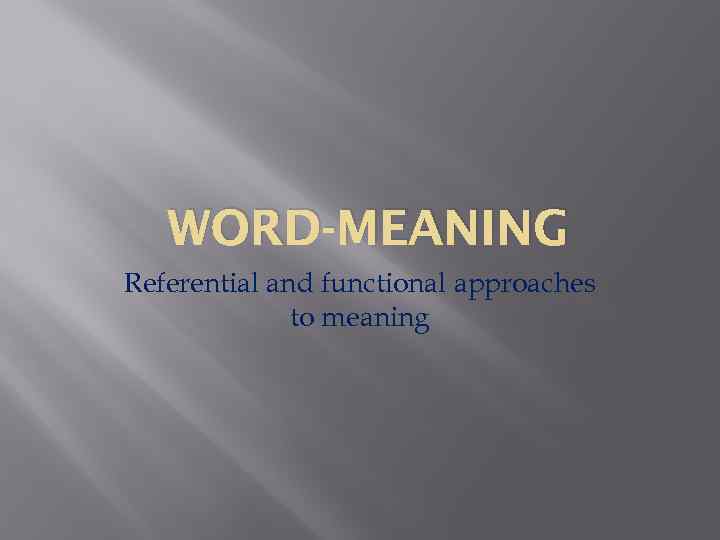
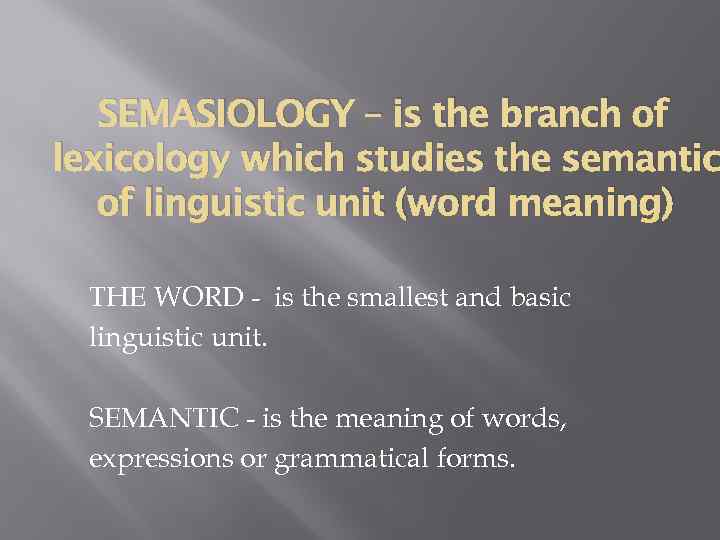
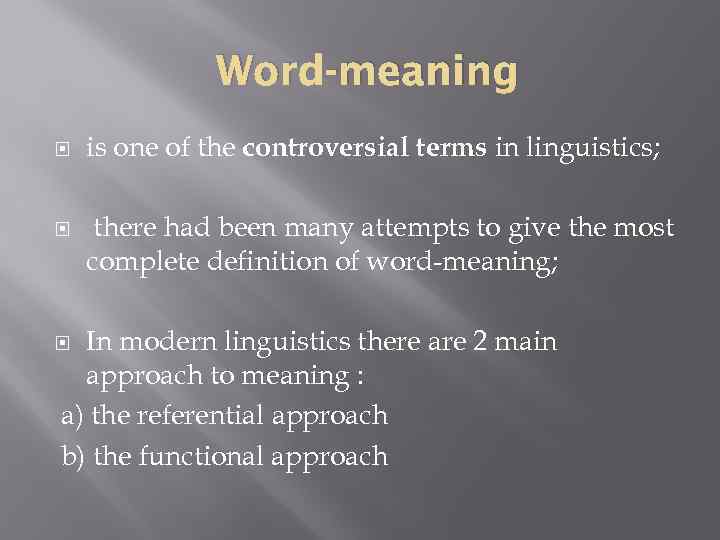
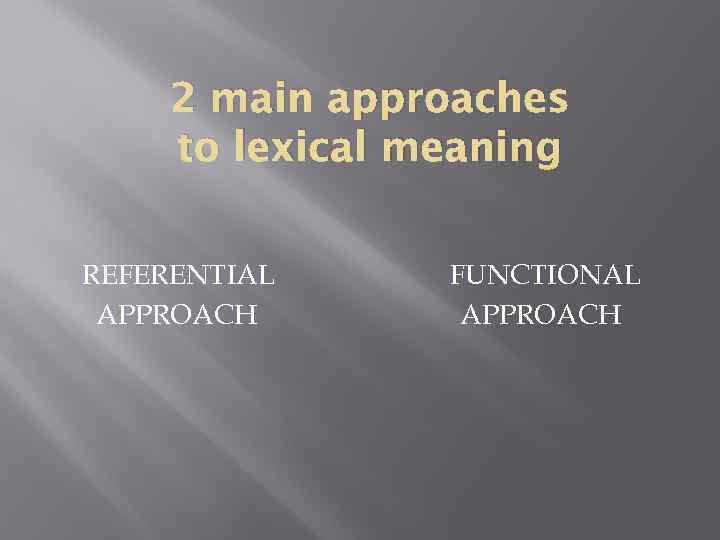
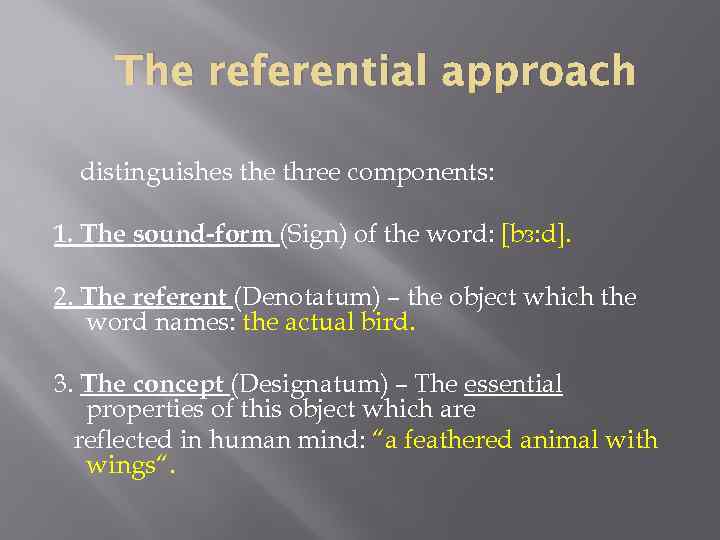
![“basic (semantic) triangle” ( referential model of meaning) ]] “basic (semantic) triangle” ( referential model of meaning) ]]](https://present5.com/presentation/1/-35581311_174906351.pdf-img/-35581311_174906351.pdf-6.jpg)
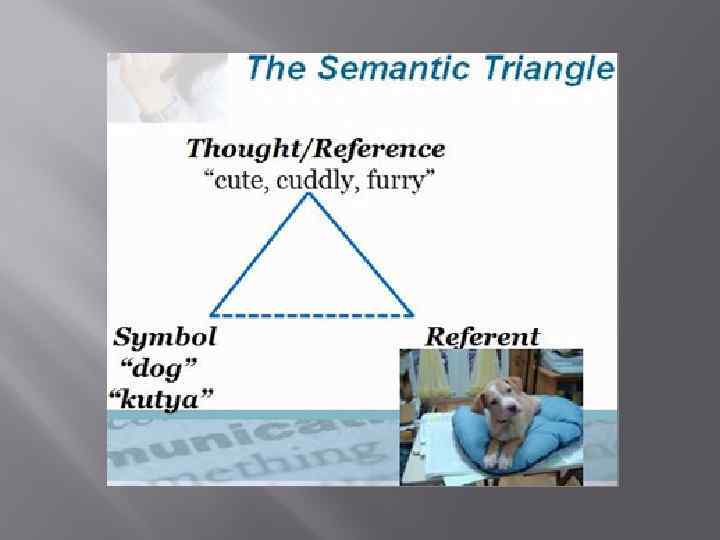
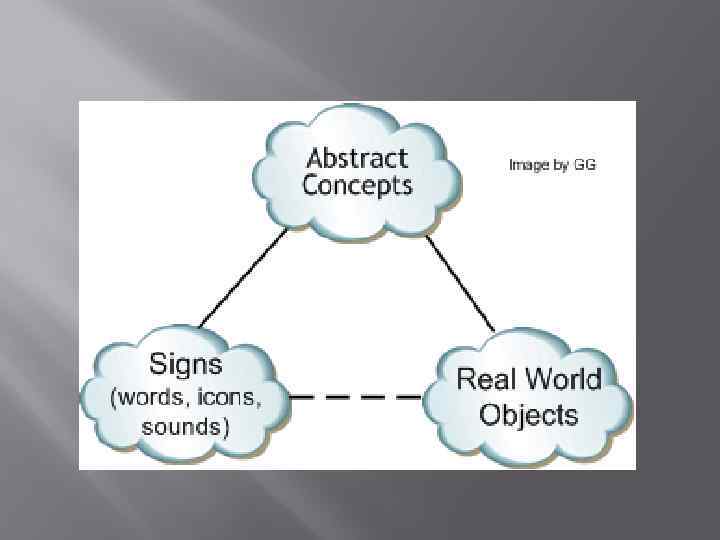
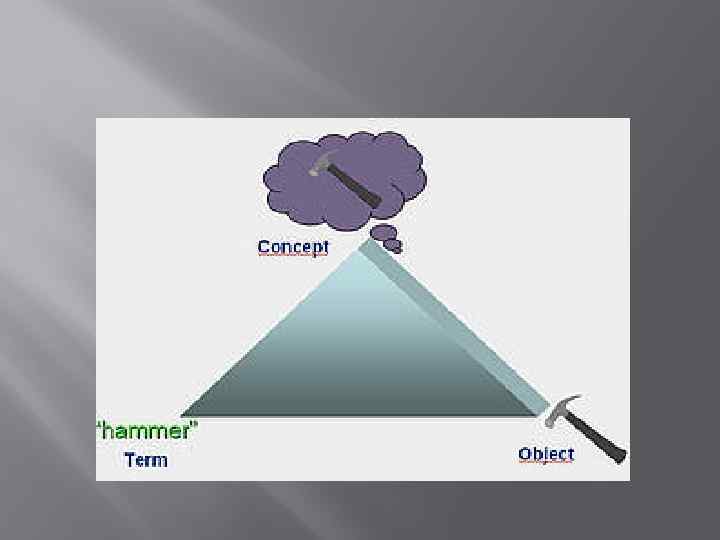
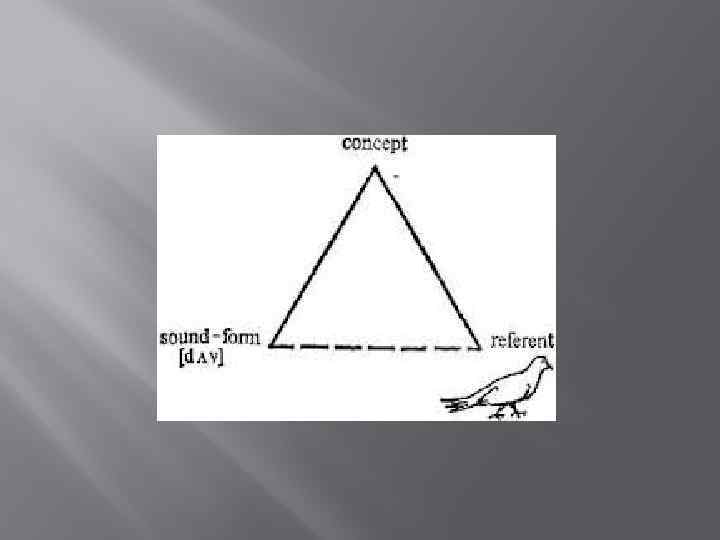
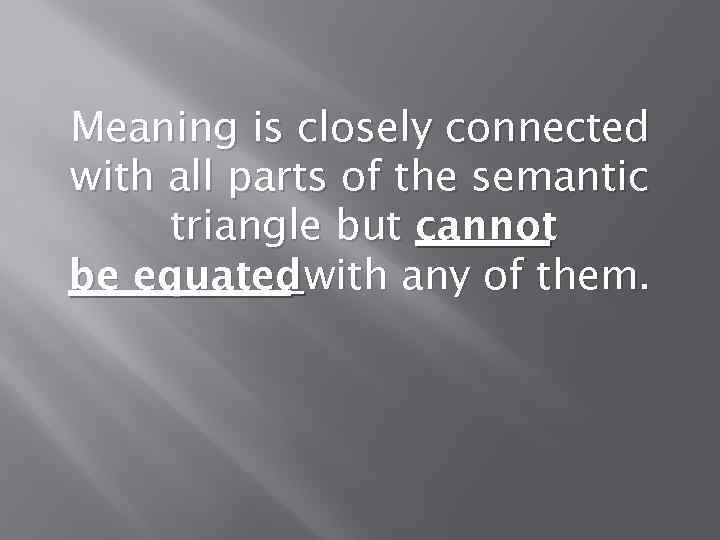
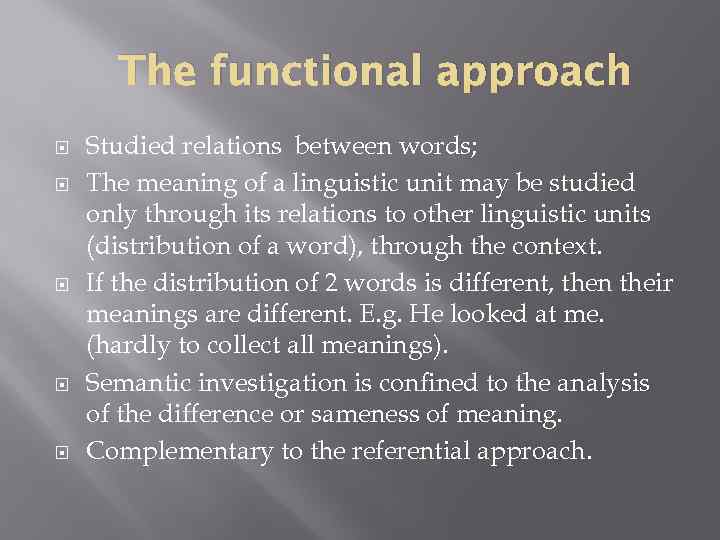
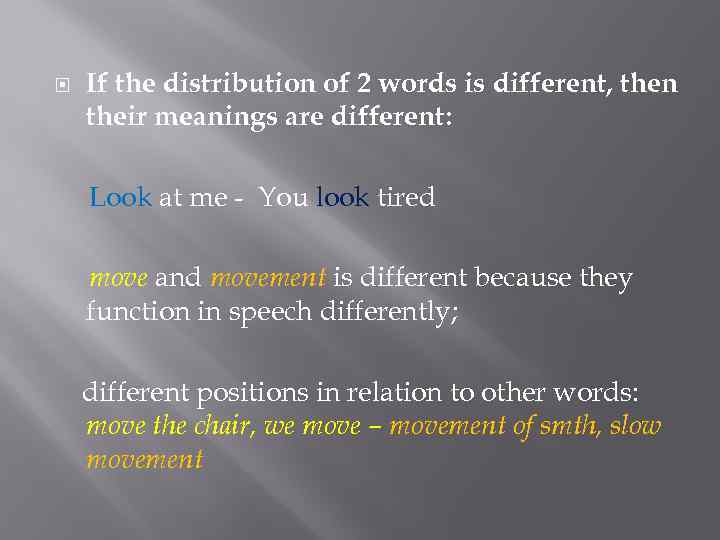
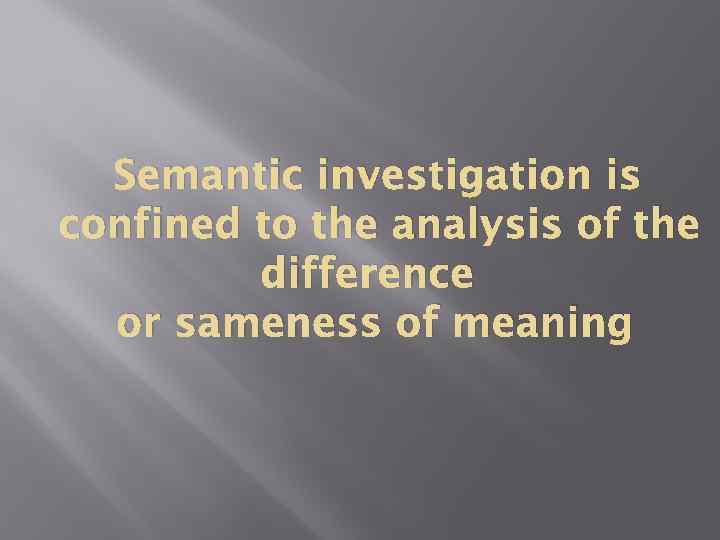
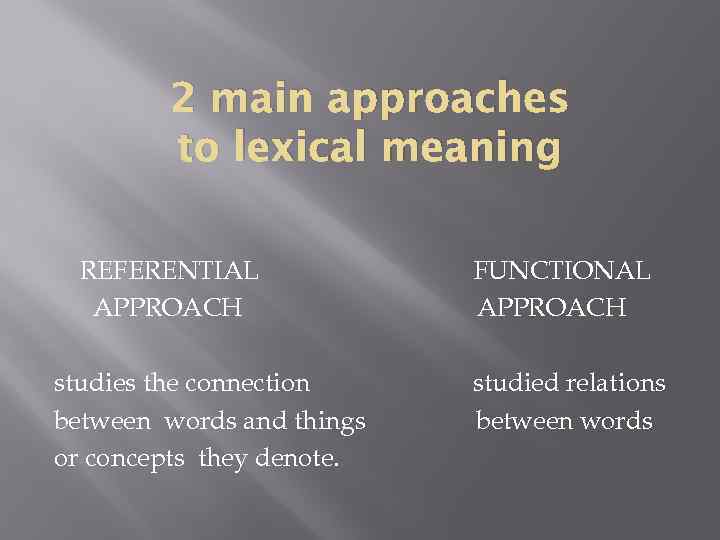








![Meaning and Sound-formare not identical
different
EX. dove - [dΛv]... Meaning and Sound-formare not identical
different
EX. dove - [dΛv]...](https://documents.infourok.ru/2d0c9b9d-1c12-4da2-8c1e-80496902c301/slide_10.jpg)








































